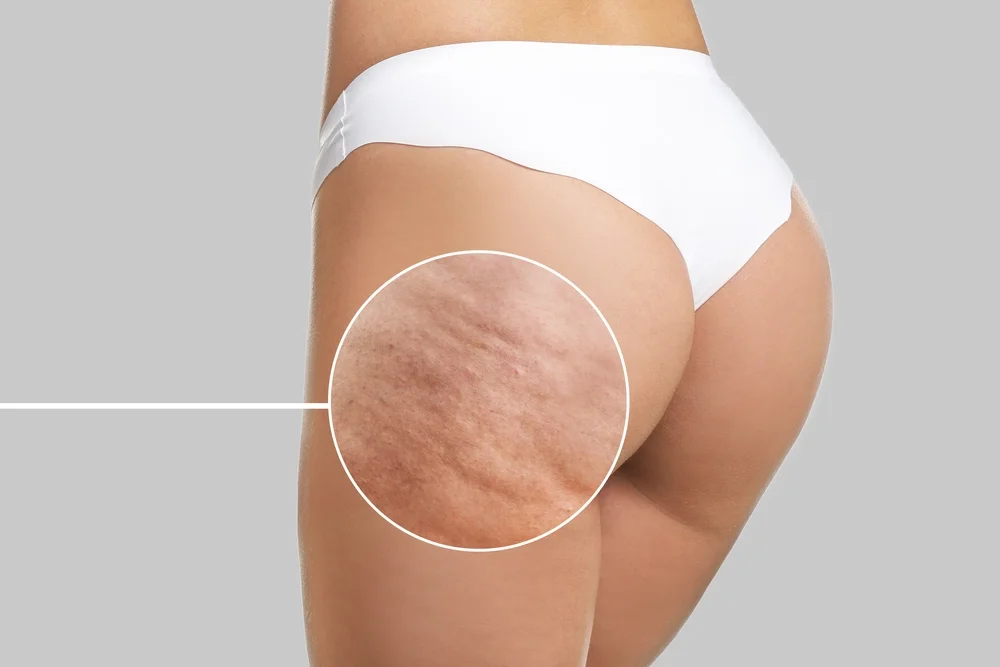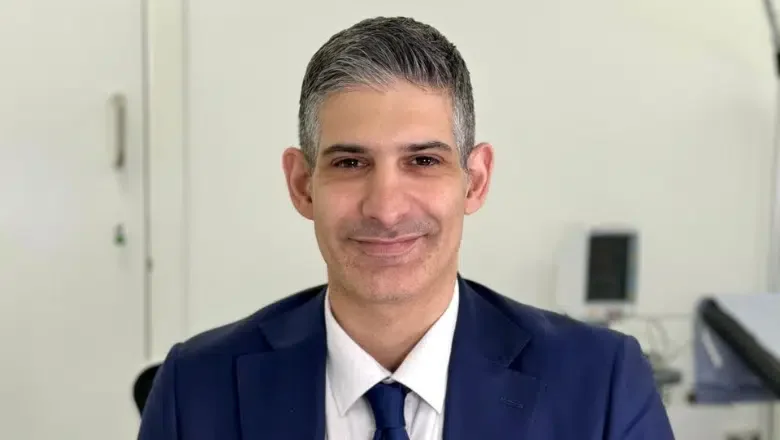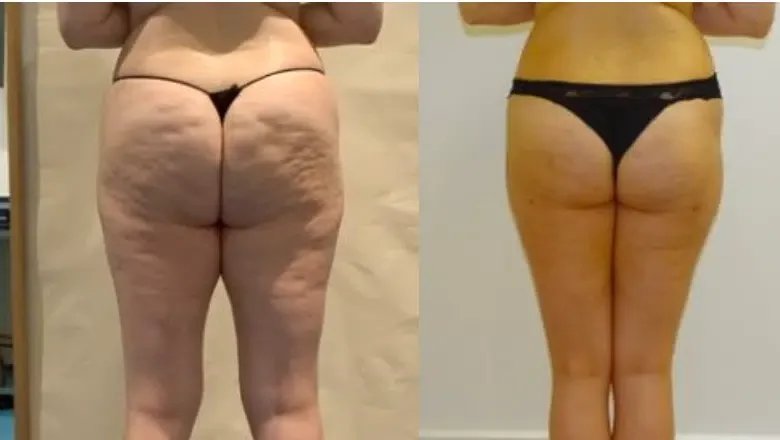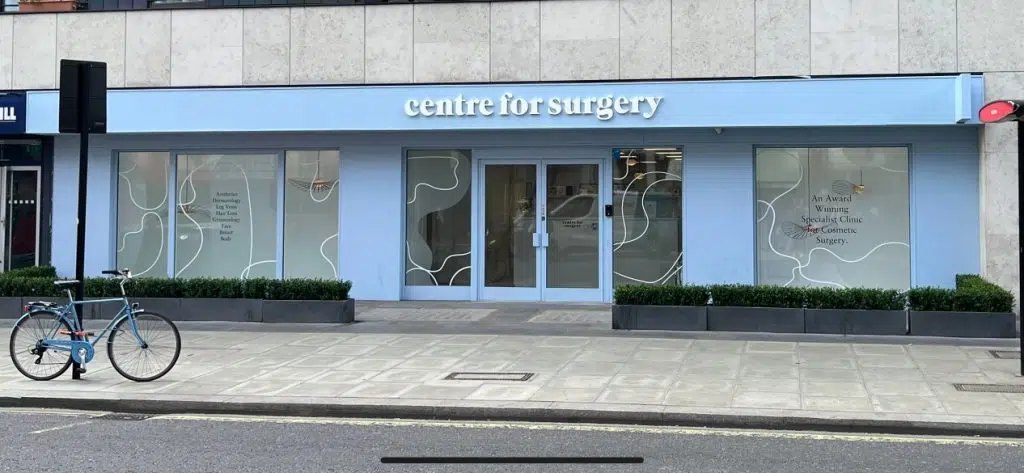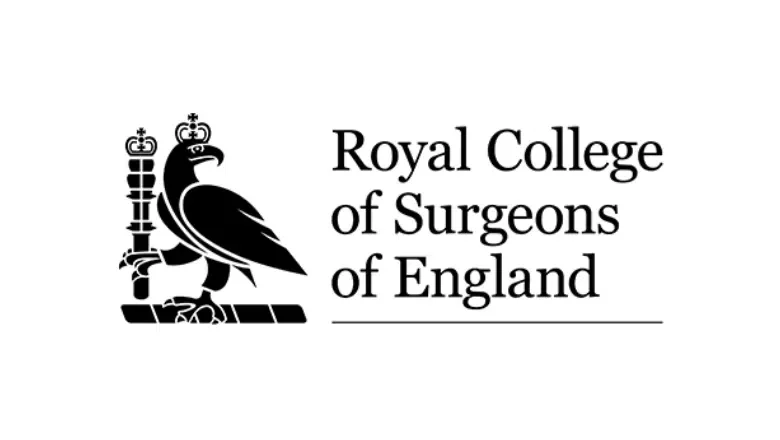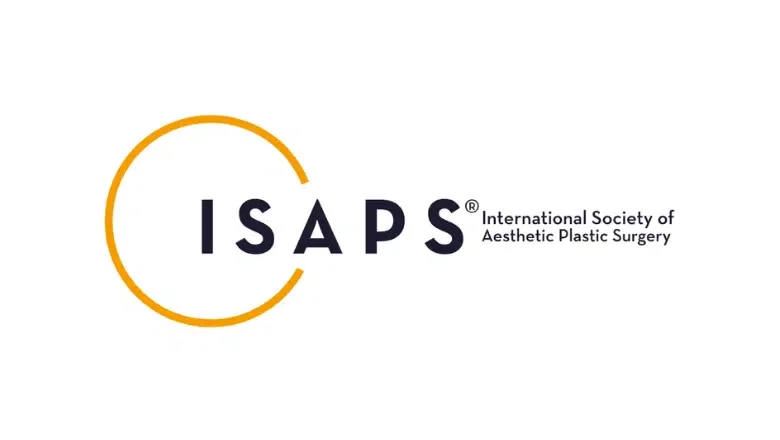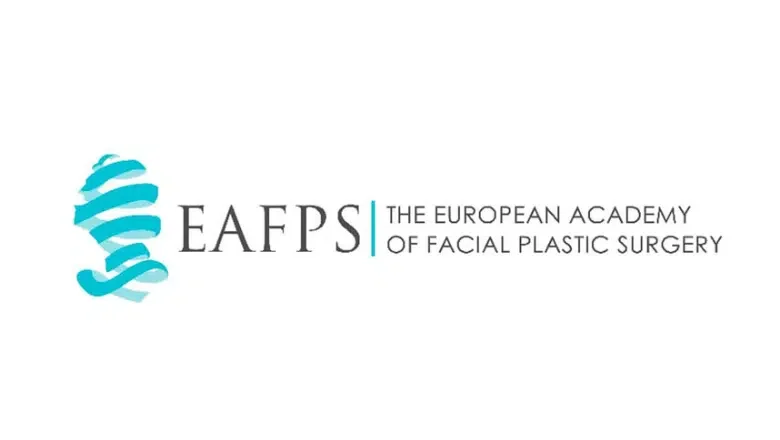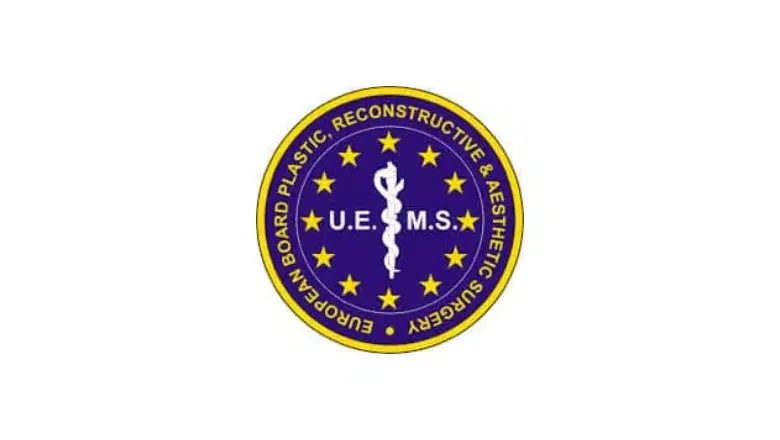Cellulite Treatment with CelluTite in London
A powerful approach to cellulite reduction involves combining cellulite subcision with argon plasma skin tightening. At Centre for Surgery, this technique is known as CelluTite. Subcision targets the underlying cause of cellulite by releasing the fibrous bands that tether the skin down, which are responsible for the dimpling effect. This allows the skin to lift and smooth out.
Once the fibrous bands are released, argon plasma skin tightening can be applied to the treated area. Argon plasma delivers controlled energy beneath the skin, stimulating collagen production and causing tissue contraction. This enhances skin firmness and elasticity, helping to refine the surface and create a tighter, smoother appearance.
By addressing both the structural cause of cellulite and the quality of the overlying skin, this dual approach offers superior results compared to either treatment alone. Patients benefit from a reduction in visible dimpling as well as improved skin tone and texture. The combination is particularly suited to those seeking long-lasting improvement with a more comprehensive treatment strategy.
RELATED: What is the best treatment to get rid of cellulite?
We are committed to delivering the highest level of care and safety to our patients. We use the latest technology and follow strict safety protocols to ensure that our patients receive safe and effective treatment. Our facilities are accredited by the Care Quality Commission (CQC), and our practitioners are fully licensed and qualified to provide CelluTite treatment.
If you’re interested in CelluTite treatment, contact Centre for Surgery today to schedule a consultation with one of our experienced practitioners. We’ll work with you to develop a personalised treatment plan that meets your unique needs and helps you achieve the smooth, even skin you’ve always wanted.
What is CelluTite?
CelluTite is a non-surgical, minimally invasive cosmetic procedure designed to treat cellulite, characterised by a dimpled or uneven skin appearance caused by fat deposits pushing through the connective tissue beneath the skin’s surface. Cellulite commonly affects areas such as the thighs, buttocks, and abdomen. CelluTite works by addressing the underlying structural causes of cellulite for a smoother, more even skin texture.
Dr Metin Nizamoglu - Specialist Plastic Surgeon
Dr Metin Nizamoglu is a specialist plastic surgeon at Centre for Surgery with advanced expertise in cellulite treatment. He is the only surgeon in the UK performing this innovative approach, which combines surgical subcision with argon plasma technology. This highly specialised technique targets the structural causes of cellulite beneath the skin, releasing fibrous bands while improving skin quality and texture for smoother, longer-lasting results. Dr Nizamoglu’s pioneering work places him at the forefront of cellulite treatment in the UK.
CelluTite Before & After Results
What causes Cellulite?
Cellulite is a common cosmetic concern that affects the appearance of the skin, causing a dimpled or lumpy texture. It is most frequently found on the buttocks, thighs, and abdomen, and is more prevalent in women than men due to differences in fat distribution, connective tissue, and muscle structure. Multiple factors contribute to the development of cellulite, including:
Fat deposits
Cellulite occurs when fat cells accumulate and push against the skin, while fibrous connective tissue bands that tether the skin to the underlying muscle pull the skin downward. This uneven tension creates the characteristic dimpled appearance of cellulite.
Hormones
Hormonal factors, particularly oestrogen, play a significant role in the development of cellulite. Oestrogen can contribute to collagen breakdown, weaken connective tissue, and influence fat distribution. Other hormones, such as thyroid hormones and catecholamines, may also be involved in the formation of cellulite.
Genetics
Genetic factors, including skin type, body fat distribution, and metabolic rate, can influence an individual’s susceptibility to cellulite. Inherited traits may determine how the body stores fat and the strength of connective tissues, which can contribute to the development of cellulite.
Age
As we age, our skin becomes thinner and loses elasticity, making cellulite more noticeable. Additionally, the connective tissue bands may become stiffer and less flexible over time, exacerbating the dimpling effect of cellulite.
Sedentary lifestyle
A lack of physical activity can contribute to the development of cellulite by causing muscle atrophy and reducing blood circulation. Regular exercise can help improve muscle tone, stimulate blood flow, and promote healthy fat distribution, all of which can help reduce the appearance of cellulite.
Diet
Consuming a diet high in fat, carbohydrates, and salt can lead to the accumulation of fat cells and the retention of excess fluid, both of which can exacerbate the appearance of cellulite. A balanced diet rich in fruits, vegetables, lean proteins, and whole grains can help support healthy skin and connective tissue, while also promoting a healthy body weight.
Smoking
Smoking negatively affects blood circulation and can contribute to the breakdown of collagen, resulting in weaker connective tissue and an increased likelihood of developing cellulite.
Dehydration
Inadequate hydration can cause the skin to lose its elasticity and contribute to the appearance of cellulite. Staying well-hydrated can help maintain healthy skin and connective tissue, reducing the likelihood of cellulite formation.
Benefits of CelluTite
CelluTite is an innovative, minimally invasive treatment for cellulite that offers numerous benefits for individuals seeking to enhance the appearance of their skin. Here is an overview of the key benefits of CelluTite Argo Plasma treatment:
Targeted cellulite reduction
CelluTite targets the underlying structural issues that cause cellulite, including fibrous bands and fat deposits. Addressing these issues effectively reduces the appearance of cellulite, resulting in smoother and more even skin.
Minimally invasive
As a minimally invasive procedure, CelluTite requires only small incisions and local anaesthesia. This means less scarring, a lower risk of complications, and a more comfortable experience for the patient compared to traditional surgical alternatives.
Quick recovery
CelluTite has a relatively short recovery time, allowing most patients to return to their daily activities shortly after treatment. While some minor swelling or bruising may be experienced, these side effects typically subside within a few days.
Long-lasting results
By targeting the root cause of cellulite and stimulating collagen production, CelluTite can provide long-lasting results that improve the skin’s appearance over time. The treatment’s effectiveness can be maintained with a healthy lifestyle and consistent skincare regimen.
Boosts self-confidence
Cellulite can be a significant source of self-consciousness for many individuals. By effectively reducing the appearance of cellulite, CelluTite can boost self-esteem and allow patients to feel more confident in their skin.
Suitable for various body areas
CelluTite can be used to treat cellulite in several areas of the body, including the thighs, buttocks, and abdomen. This versatility allows patients to address their specific concerns and achieve comprehensive improvement.
Collagen stimulation
The mechanical action of Cellutite’s oscillating cannula promotes collagen production in the treated area. Increased collagen levels result in firmer, more elastic skin, further enhancing the treatment’s overall effectiveness.
Safe and effective
CelluTite is a safe and effective treatment option for cellulite when performed by an experienced and qualified practitioner. It has a lower risk of complications compared to more invasive surgical procedures.
Ideal candidates for CelluTite
The key to successful treatment for cellulite reduction is a combination of several factors, which you will be assessed for at your consultation:
- Patients in good physical and mental health
- Those at or near their ideal body weight
- Patients with realistic expectations of what the CelluTite procedure can achieve for them
- Patients who would like to reduce or ideally remove the cellulite from the areas of concern
- Patients who would like to achieve a smoother skin appearance with tighter, more elastic skin
- Patients tired of ineffective treatments tried elsewhere, including lotions and non-invasive salon-grade energy devices
You will be an appropriate candidate for this procedure if you have a mild/ moderate or severe amount of cellulite which you want to remove. You must be at least 18 years old, but there is no upper age limit. This treatment is suitable for both women and men who have cellulite.
CelluTite Procedure
First, the area to be treated is marked so the surgeon knows exactly where the dimples are. A local anaesthetic is then applied to keep you comfortable throughout the procedure.
Next, cellulite subcision begins. A tiny specialised needle or cannula is inserted just under the skin. The surgeon carefully moves this instrument to release the fibrous bands that are tethering the skin down and causing the dimpled effect. Each dimple is treated one by one, allowing the skin to lift and smooth out.
Once the subcision is complete, argon plasma skin tightening is performed over the same area. A thin wand delivers controlled plasma energy beneath the skin’s surface. This energy generates gentle heat, which contracts the tissues straight away and stimulates new collagen production in the deeper layers.
You may feel warmth during this part, but it is generally well tolerated. The combination of releasing the fibrous bands and tightening the skin means you not only get rid of the “pulling down” effect, but also improve firmness, elasticity and texture in the treated zone.
Finally, the area is cooled and dressed if needed. Most patients can go home the same day and return to normal activities within a couple of days, although some bruising and swelling can be expected while the skin heals and remodels.
Recovery after CelluTite - What to Expect
Recovery after CelluTite treatment is generally quick and straightforward, with most patients able to resume their daily activities within a few days of the procedure. Here is an overview of what to expect during the recovery period:
Immediately after the procedure
After the procedure, patients may experience some swelling, bruising, and discomfort in the treated area. Your practitioner may apply a compression garment to reduce swelling and encourage healing. Patients are typically able to return home the same day as the procedure.
First few days
During the first few days after CelluTite treatment, patients are advised to rest and avoid strenuous activities. Over-the-counter pain medication may be recommended to manage any discomfort or pain. Patients should also drink plenty of fluids to aid in healing and avoid alcohol and caffeine, which can dehydrate the body.
One week after treatment
After about a week, patients may begin to notice an improvement in the appearance of cellulite as the treated area heals. Swelling and bruising should begin to subside, and patients can gradually increase their activity levels. However, it is still advisable to avoid high-impact exercise or activities that could strain the treated area.
Two weeks after treatment
By the two-week mark, most patients should be able to return to normal daily activities. Any remaining bruising or swelling should continue to improve, and patients may notice further improvements in the appearance of their skin. However, it is still advisable to avoid heavy lifting or strenuous exercise until cleared by your practitioner.
Long-term recovery
While CelluTite offers long-term benefits for cellulite reduction, it is important to maintain a healthy lifestyle and skincare regimen to preserve these results. Patients should continue to drink plenty of fluids, exercise regularly, eat a balanced diet, and avoid smoking to promote healthy skin and connective tissue.
CelluTite Costs London - How much does CelluTite cost in London UK? Prices & Fees
The cost of CelluTite treatment can vary depending on several factors, including the size and location of the treated area, the severity of cellulite, and the number of sessions required to achieve optimal results. It is important to consult with a qualified and experienced surgeon to determine the most appropriate treatment plan for your specific needs and to discuss the associated costs. We offer a range of financing options to help make CelluTite treatment more affordable for our patients.
CelluTite at Centre for Surgery
Centre for Surgery in London is an excellent choice for CelluTite treatment for several reasons:
Expertise
Our practitioners are highly experienced in CelluTite treatment and are experts in minimally invasive cosmetic procedures. They have undergone extensive training and have years of experience in the field, ensuring that they provide the highest level of care and deliver optimal results for their patients.
Personalised treatment
At Centre for Surgery, we believe in providing personalised treatment plans tailored to the specific needs of each patient. We take the time to understand each patient’s goals and concerns, and we work with them to develop a treatment plan that addresses their unique needs.
State-of-the-art facilities
Our state-of-the-art facilities are equipped with the latest technology and equipment, ensuring that our patients receive the highest level of care in a comfortable and safe environment.
Focus on safety
At Centre for Surgery, patient safety is our top priority. We follow strict safety protocols and guidelines to ensure that our patients receive safe and effective treatment. Our practitioners are fully qualified and licensed, and our facilities are accredited by the Care Quality Commission (CQC) to ensure the highest standards of safety and quality.
Exceptional patient care
We are dedicated to delivering exceptional patient care throughout every stage of the treatment process. Our friendly and knowledgeable staff are always available to answer questions and provide support. We offer a range of financing options to make treatment more affordable for our patients.
FAQs
-
What is cellulite?Cellulite is dimpled skin which generally appears in the thighs, hips, and buttocks. Cellulite occurs when fatty deposits push and distort the connective tissue beneath the skin. This results in the skin appearing lumpy and dimpled. It more commonly occurs in women, however, it can occur in men as well.
Cellulite is a remarkably common cosmetic nuisance that affects up to 80 - 90% of women and about 20% of men in the UK. Cellulite can occur in younger people as well as older people and can arise anyone on the body. It does however most commonly occur on the buttocks and outer thighs but can also occur on the back and upper arms. Cellulite tends to occur where the body’s fat stores are well developed. The underlying process leading to cellulite is complex but is thought fundamentally to be due to the connective tissue strands beneath the skin becoming taut and rigid. Intervening pockets of fat against the unyielding connective tissue fibres get forced upwards against the undersurface of the skin. This gives rise to the very familiar dimpled appearance of cellulite. The appearance of cellulite can be aggravated by thinner skin which leads to more severe grades of cellulite.
Many treatments for cellulite have been tried over the years however the most effective treatment is CelluTite which is a combination of cellutlite subcision and argo plasma skin tightening that acts deeper to target the underlying cellulite and fat whilst tightening the overlying skin through the production of new collagen and elastin. -
What are the causes of cellulite?It is still not fully understood what causes the development of cellulite but there are a number of factors which are associated with the occurrence of cellulite and these include:
- Hormonal imbalances caused by pregnancy or menopause
- Significant weight gain or weight loss
- The ageing process leading to a loss of skin laxity
- Poor diet and lack of exercise -
Why does cellulite affect women more than men?Cellulite is remarkably common in women where up to 95% have some form of cellulite and this is entirely normal. Cellulite is much less common in men and this is because men have less overall body fat in the areas where cellulite is typically found. In men, the structural organisation of fat differs from women in superficial layer in particular where the fat assume a flatter configuration as opposed to fat cells which are more vertically oriented in women. Hormonal influences in women leads to characteristic distribution of fat in areas such as the thighs, buttocks and hips and the same hormones also mediate the formation of cellulite in the same areas.
Men also have a different arrangement of fat in the superficial layer of skin, which are arranged flatter, rather than as vertical columns. The influence of female hormones in cellulite is mainly down to fat distribution, as it is at puberty that girls develop fat over the buttocks, hips and lower abdomen where cellulite most commonly occurs. -
Does cellulite get worse with time?Cellulite does have a tendency to get worse with time. This is often due to the skin becoming thinner as a result of diminished production of collagen and elastin. This leads to skin laxity and exacerbates the appearance of cellulite in the thighs or buttocks.
Your surgeon will explain the characteristics of cellulite and what factors make it worse over time. -
What is CelluTite and why is it so effective?CelluTite is the name given to the combined procedure of cellulite subcision with argon plasma skin tightening, designed to deliver superior results for the treatment of cellulite.
Cellulite develops when fibrous bands beneath the skin tether it down, creating dimples, while surrounding fat pushes upwards. Traditional treatments often only focus on the surface, but CelluTite works at both levels – the underlying structure and the overlying skin.
The first stage of CelluTite involves subcision, where a fine cannula is inserted under the skin to release those tight fibrous bands. This allows the skin to lift, reducing the depth of the dimples. The second stage uses argon plasma energy to heat the tissues just beneath the skin’s surface. This causes an immediate tightening effect while also stimulating the production of new collagen and elastin, which strengthens and smooths the skin over time.
The combination of these two steps means CelluTite doesn’t just smooth out dimples – it also firms and improves the overall texture and elasticity of the skin. This makes it one of the most advanced and comprehensive treatments available for cellulite, offering results that are more natural-looking and longer-lasting than with either subcision or skin tightening alone.
The CelluTite procedure is a significant improvement over laser and radiofrequency treatments for cellulite and is the only minimally invasive treatment for cellulite that is backed by solid scientific data to support its safety and effectiveness. -
What are the advantages of CelluTite?The biggest advantage is that it tackles cellulite at its root cause. Subcision releases the fibrous bands beneath the skin that pull it down and create dimples. Once these are freed, the skin can lift and smooth naturally. At the same time, argon plasma works on the overlying tissue, tightening and firming the skin for an even better surface result.
Patients often notice that their skin looks smoother, firmer and more even in tone. Because argon plasma stimulates collagen and elastin production, improvements continue to build over time, with results becoming more refined in the months following treatment. This also means the outcome is long-lasting, particularly compared with surface-only treatments like creams or massages.
Another key benefit is that both treatments are minimally invasive. They are performed under local anaesthetic, with no need for an overnight stay, and recovery is much quicker than with more invasive surgical procedures. Most people can return to everyday activities within a couple of days.
By combining the two techniques, you not only reduce dimpling but also improve the overall quality, tightness and resilience of the skin, creating a more youthful and refined appearance.
Each year there are many millions of people who end up spending a large amount of money on ineffective creams, gels and lotions to rid themselves of the unsightly dimpling and skin laxity which characterises cellulite. CelluTite is a ‘one and done’ minimally invasive surgical treatment performed under local anaesthetic as a day case at Centre for Surgery. -
Which areas of the body can be treated with CelluTite?CelluTite can be used on most parts of the body where cellulite is commonly found, particularly in areas where dimpling and skin laxity tend to appear together.
The most popular treatment zones are the buttocks and the thighs – both front and back – as these are the areas where cellulite most often develops. The outer thighs (saddlebags) and inner thighs can be effectively smoothed and tightened, helping to restore a firmer contour.
CelluTite is also highly effective on the hips and flanks, which often show rippling and unevenness, as well as the upper arms, where skin laxity can make cellulite more visible. In some cases, it can even be applied to the abdomen if there is surface irregularity combined with skin looseness.
Because it combines subcision with plasma tightening, CelluTite is versatile and can be adapted to different body shapes and skin types, making it suitable for patients who want a more comprehensive improvement across several areas. -
Which surgeon performs CelluTite treatment at Centre for Surgery?At Centre for Surgery, the combined procedure of cellulite subcision and argon plasma skin tightening—commonly referred to as CelluTite—is performed by Mr Metin Nizamoglu, a Consultant Plastic, Reconstructive and Aesthetic Surgeon based at our Baker Street clinic in London.
Mr Nizamoglu brings over 14 years of NHS experience, including a consultant post at the St Andrew’s Centre for Burns and Plastic Surgery. He holds fellowships with both the Royal College of Surgeons of England (FRCS Plast) and the European Board of Plastic, Reconstructive and Aesthetic Surgeons (EBOPRAS), and is on the GMC specialist register for plastic surgery. -
Am I a good candidate for CelluTite?You will be a suitable candidate if you have cellulite which you are wishing to remove.
You will need to be at least 18 years old to be suitable for treatment. -
What is the best or most effective cellulite removal treatment?Although there are many heavily promoted treatments for removal of cellulite, the most effective cellulite treatments are those which directly target the causes of cellulite using minimally invasive surgical techniques such as CelluTite radiofrequency treatment at Centre for Surgery. CelluTite produces effective results in a single treatment session.
Other cellulite treatments include :
Laser cellulite treatment
Weight loss
Topical creams and lotions
Massage
These treatments are not effective long-lasting options for treatment of cellulite as they do not address the underlying changes in the cells causing cellulite.
Although a good diet and exercise are highly effective for fat reduction, the skin elasticity does diminish especially with significant weight loss. The application of creams and lotions achieve minimal to no significant improvement in cellulite despite the active ingredient of caffeine which achieves only a temporary improvement in cellulite treatment. -
Are there alternative cellulite treatments other than CelluTite?There are many different treatments for reducing the appearance of cellulite and not all are effective.
Non-surgical methods of cellulite removal include weight loss and topical treatments such as creams and lotions as well as professional massage therapy and collagen drinks. All the alternative cellulite treatments exert only a superficial effect on the uppermost part of the skin at best but fail to address the underlying cause of cellulite formation which lie at a deeper level in the skin which only CelluTite can achieve.
At Centre for Surgery, we focus on providing tried and tested treatments with a firm base of evidence proving treatment efficacy. CelluTite is an FDA approved treatment using radiofrequency energy in a minimally invasive manner for effective removal of cellulite. -
What anaesthetic will be used for CelluTite?CelluTite is performed under a local anaesthetic often with oral sedation to make you feel relaxed and drowsy during treatment. Once you are mildly sedated, the surgeon will inject local anaesthetic into the areas to be treated. Sometimes the injection of local anaesthetic may be a little uncomfortable and so you may be offered Nitronox which is a mixture of nitrous oxide and oxygen to relieve any discomfort.
-
How long does CelluTite take to perform?The CelluTite procedure takes between one to two hours to perform and will depend on the number of areas being treated.
The treatment is comfortably performed under oral sedation and local anaesthetic. -
How is CelluTite performed?CelluTite involves the use of radiofrequency energy to tighten the skin and improve the appearance of cellulite.
The surgeon will make a small incision and will insert a cannula beneath the skin. The cannula has a special two-pronged tip to physically disrupt the vertical cellulite bands and simultaneously emit radio-frequency energy leading to a bulk heating effect of the surrounding tissue. As a result of this, the skin should begin to tighten. This dual action releases the areas of cellulite, leading to smoothening of the overlying skin. -
How many treatments will I need to undertake?You will only need to have one CelluTite treatment. CelluTite is a one and done procedure with no need for further treatments. Occasionally in very severe cases of cellulite, a further treatment may be required to release severely constricted bands.
-
When can I expect to see results from CelluTite treatment?Immediately after the procedure, there will some visible improvement followed by continued further improvement over the next 3-6 months. Final results should be apparent at the 6 month mark.
-
Is CelluTite a permanent form of cellulite treatment?Treatment with CelluTite radio frequency produces results that are long-lasting and permanent in nature as the treatment specifically targets the internal bands of cellulite with high energy radio-frequency and physically disrupts them.
It is generally the case that cellulite has a tendency to get worse over time and so there is a small possibility of the condition recurring albeit in a much more minor way than if cellulite treatment had not been performed in the first place.
We would also recommend to maintain a healthy stable weight without any fluctuations in weight to maintain a cellulite-free state over time. -
Is cellulite treatment with CelluTite painful?The cellulite treatment is a very well tolerated procedure when performed under local anaesthetic often combined with mild tablets sedation. It is common to have localised swelling and bruising in the area of treatment but this improved significantly within the first few days. Any mild discomfort can be easily managed with a course of oral painkillers.
-
Is cellulite treatment safe?Yes – when performed by a qualified and experienced plastic surgeon, CelluTite is considered a safe and effective treatment for cellulite. Like all medical procedures, it does carry some risks, but these are generally low, especially when compared with more invasive surgery.
Because CelluTite is done under local anaesthetic, there is no need for a general anaesthetic, which already reduces the overall risk. The procedure is minimally invasive, meaning only tiny entry points are made in the skin. Most patients experience some temporary bruising, swelling or tenderness in the treated areas, which usually settles within a couple of weeks.
The argon plasma element of the treatment is carefully controlled to heat the tissue in a precise and safe way, tightening the skin without damaging the surface. Collagen production is stimulated gradually, so the improvements continue to appear naturally over the months following treatment. -
What will the recovery period be like?There is a minimal recovery period associated with this procedure. Bandages will be applied to the treatment area. These can be removed the following day. You may notice some bruising and swelling which will last a few days. You will be able to return to your usual routine straight away.
-
Where is Centre for Surgery located?Centre for Surgery is located at 95-97 Baker Street in Marylebone.
We are easily accessible by all major bus routes that pass through Baker Street as well as Baker Street underground station.

